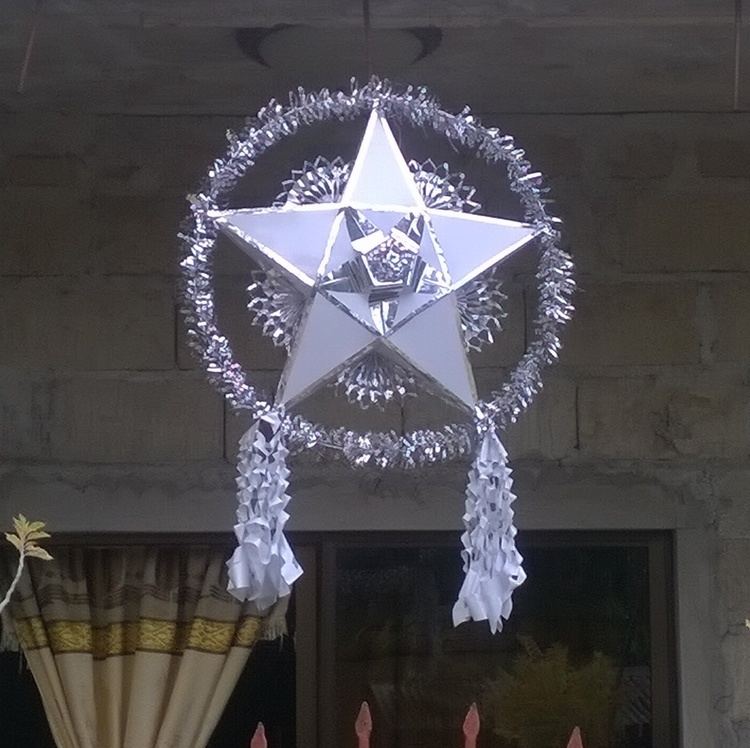 | ||
A parol is an ornamental, star-shaped Christmas lantern from the Philippines. It is traditionally made out of bamboo and paper and comes in various sizes and shapes, but generally the basic star pattern remains dominant.
Contents
The design of the parol evokes the Star of Bethlehem that guided the Three Kings to the manger. It also symbolizes the victory of light over darkness and the Filipinos' hope and goodwill during the Christmas season.
Etymology
The word parol is derived from the Spanish word farol, meaning "lantern". Another, less-known name for this and lanterns in general is paritaán.
History
Patterns of the parol evolved from the five-pointed paper star lantern originally crafted in 1908 by an artisan named Francísco Estanislao. His creation was made of bamboo strips covered with papél de japón (Japanese paper), illuminated by a candle or kalburo (carbide). This kind of lantern was used by barrio folk to light their paths during the ritual yuletide dawn Masses called Misa de Gallo, as electricity was yet unavailable at the time in many rural areas.
Construction and design
Traditionally, parols have a star-shaped framework made of bamboo sticks which are then covered by coloured pieces of either Japanese paper or crêpe paper. The most common form is a five-pointed star with two decorative "tails".
Nowadays, the materials range from plastic, shells, glass, beads, foil, feathers, hemp, leaves, seeds, soft drink straws, wood and even metal. They usually come in various sizes, from small, tinsel and foil lanterns to gigantic ones that are electrically lit at night, and may have one, three or more tails aside from the ubiquitous two. Some have a surrounding "halo," and the number of points on the star usually ranges from four to around ten (however, higher numbers exist). As for stellate patterns, more complex shapes that are seen are the rose, the bromeliad, the snowflake and the sea urchin.
Other designs aside from the common stellate pattern include that of angels, huge flowers, Santa Claus's face, reindeer, happy faces, and Christmas trees, among other Western holiday symbols.
Recently, innovations from Pampanga include production of lanterns with electronic lights that can be programmed to produce a dancing effect, as is the use of LED rope lights, known as "flexilight" lanterns.
The original stellate design of the parol remains common in the Philippines and considered distinct for Filipinos. The traditional craft of lantern-making is usually taught to schoolchildren around Christmastime, but actual manufacture is now primarily done in the barrios and the poblacions and is rarely done in urban areas. A notable exception is Parañaque, a city in Metro Manila, which has the largest parol-making industry in the Philippines, and San Fernando, Pampanga, where a lot of parols also originate.
In the Philippines
In the Philippines, the parol has become an iconic symbol of the Filipino Christmas and is as important to Filipinos as the Christmas Tree is to Western cultures. Its annual debut on houses and streets is usually in September along with other Christmas symbols, signalling the coming of the season. The parol also retains its original association with the Simbang Gabi ritual, a series of dawn masses that lasts for nine days. These lanterns remain until January, traditionally removed after Epiphany, to honour the Three Kings and their visit to the infant Jesus.
Many communities, such as villages, schools, and groups hold competitions to see who can make the best parol. One such event is the annual Giant Lantern Festival in Pampanga, which attracts various craftsmen from across the archipelago. The competition revolves around the illumination and performances of giant parol that can reach up to 40 feet (12 m) in breadth. These giant lanterns are programmed to "dance" to the accompaniment of a brass band.
Overseas
Although the use of the parol as a Christmas decoration is chiefly done in the Philippines, other countries where the Filipino diaspora have settled have also adapted its use. In Austria, the lanterns are a big attraction in the annual Wiener Christkindlmarkt (Vienna Christmas Market). A ceremonial lighting of 60 parol in a 'Philippine Tree' was done at the Wiener Rathausplatz. The project was a collaboration between the city's government and the Philippine Embassy in Vienna, which introduced the lanterns in 2006.
Since 2005, renowned artist, Fred Deasis, offers free Parol Making Workshop to the Filipino community in the Chicago, Illinois area and adjacent states. Workshops were coordinated by public libraries, community churches and local Filipino American cultural organizations. During the workshop, participants learn to make a traditional Filipino Christmas parol, originally designed by the artist, with the use of only 5 bamboo sticks, japanese paper, rubber bands, wire, glue and ornaments.
In San Francisco and Los Angeles, California, Filipino Americans celebrate an annual parol Festival in December. Parols are also common as Christmas decorations for Filipino-American homes and churches. Filipinos in Canada hang parols in their party halls during Christmas parties to reminisce their traditional usage of the craft.
